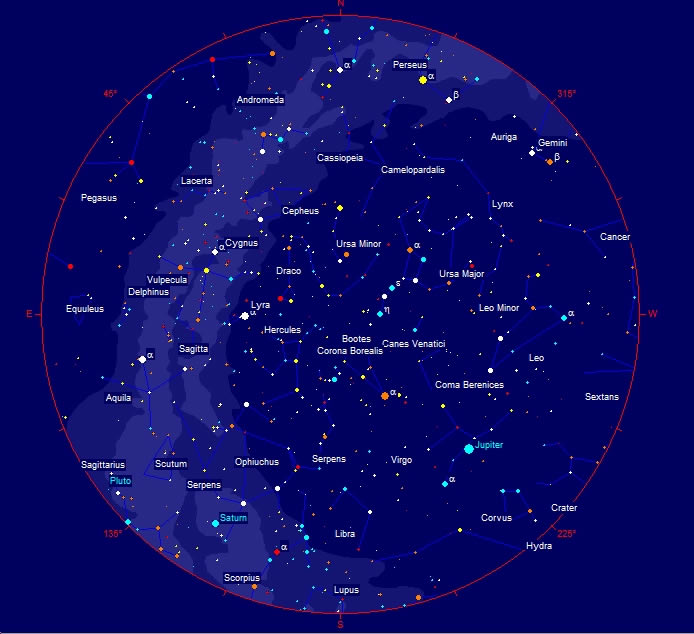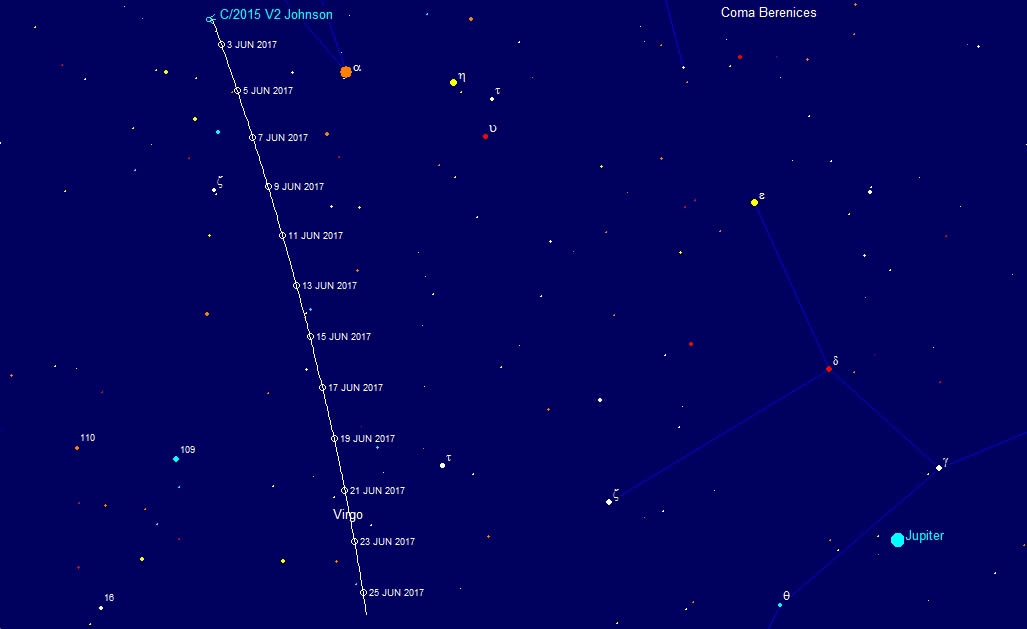Blog
Night Skies - June 2017
The chart shows the night sky for Mid June at around 11 PM.
In June, the night sky never really achieves a truly “dark” state as the Sun is never more than 18 degrees below the horizon and the longest day of the year or “Summer Solstice” falls on the 21st of the month. Although officially the start of summer, astronomically speaking, the Earth is actually at it's furthest point from the Sun in it’s orbit at this time, hence why we have milder winters and cooler summers than our Southern Hemisphere compatriots……. or at least that's the theory!!
Looking to the skies however, and we still have a couple of planets on show for the month. Jupiter still continues to dominate the South and South Western sky when darkness falls, displaying it’s usual retinue of four bright moons and cloud belts on the planetary disc. The Moon pays a visit to Jupiter’s area of the sky around the 3rd of June, with a repeat visit at the end of the month on the 30th for those wishing to grab a photo opportunity.

Rising low in the SE at Sunset, so visible all night long, is the ringed planet Saturn. Although at it’s best for viewing at the moment, the planet is at a very low point in the sky, never more than around 15 degrees - or 30 full moon diameters - above the South horizon and it will remain poorly placed for the next handful of years as it slowly orbits our Sun, climbing as it does to higher altitudes in the celestial sphere. To give an idea of what the planet looks like in a small telescope, a photo taken by me through a scope is attached. A bright Full Moon will lie 2o or 4 moon diameters above the planet on the night of the 10th June.
The final planet easily seen this month is Venus, though this one is for the early risers amongst you. Looking towards the Eastern horizon anytime from 4AM onwards and you should pick out the bright point of light that is Venus, approx 15o above the lightening dawn sky. A simple “camera phone” shot taken by me a couple of weeks back gives you an idea of what to look for, and also demonstrates that simple astro photography is surprisingly easy. Hold the mobile steady, and having selected a Sunrise/Sunset or low light option on your camera settings, zoom in to select a section of the horizon and the planet and gently fire the shutter control. Simples!!! As a further identification aid to Venus, around the 20th and 21st of June, a crescent Moon will be close by, adding to your photo composition.
There is one meteor shower on display for the month, the Bootids, emanating from the kite shaped constellation of Bootes that can be found roughly in the middle of the sky chart. It is a rather under observed shower due to the highly variable rates of meteors that the shower produces. Figures from 5 to 100 meteors per hour have been experienced by observers in the past, and this year could be favourable since the Moon will be well out of the way during the time of expected maximum activity around the 27th of June.
We still have one “almost naked eye” comet around, Comet Johnson, although a Full Moon on the 9th of the month will tend to interfere with observations for some days either side. It’s a shame that, as the Comet will be nearest the Earth on the night of the 5th, and should be at it’s brightest around then. A chart is supplied to help track down this celestial visitor that should been observable with tripod mounted binoculars.

The final thing or “things” to look out for during this and the next couple of months are noctilucent clouds. These are very high altitude clouds composed of dust and ice crystals that form some 50 miles high up in our atmosphere and are so still illuminated by the Sun some 1 ½ to 2 hours after Sunset and before Sunrise. Look low down to the NW sky after Sunset and to the NE sky prior to Sunrise and you may glimpse these ethereal “electric blue” clouds as shown in the NASA pic attached.
Well, there’s a few things to keep your eyes open for, even with the short Summer nights ahead, so good luck and clear skies!
Les Fry – Mid Wales Astronomy.
